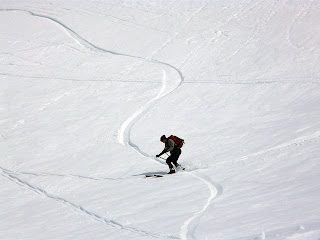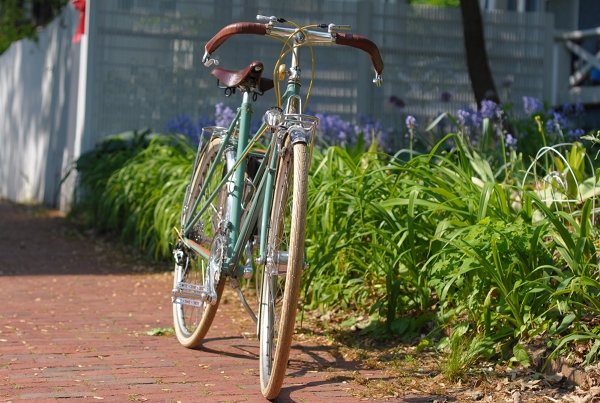
Mr. Rab Carrington himself, at a crag in Osp, Slovenia. photo couresty of Veronika
The "RAB" stands for Rab Carrington. For guys like me of a similar generation Rab Carrington was one of the hard Brits running around the Alps and later the greater ranges knocking off the plums.
"In the 70’s, you weren’t a rock climber, you were a mountaineer. In winter you ice climbed, in spring you tried to get rid of the winter fat, in the summer you went to the Alps, then you did a bit in the autumn before it closed in for the winter - the drinking season.
In 73/74 we started going to the Alps in winter. We went out, a team of Brits, not knowing much, doing our own thing. We were aiming for a speedy style, but the first route took Al and me two days, and we later found out that Patrick Vallençant had skied down it in about 15 seconds.
The whole team of us shared an apartment. That was a wild time, totally drunken and debauched. We didn’t get our deposit back at the end of the season, that’s for sure.
I learned how to make sleeping bags by accident. Al Rouse and I had a completely abortive trip to Patagonia in 1973, when we travelled overland from the USA. We got to Buenos Aires to pick up our climbing gear - which was being shipped out from Liverpool - only to find the gear hadn’t even left the port thanks to a dock strike. We partied instead, but I also ended up working for Hector Vieytes, a friend of mine, for six months in Argentina, and that’s were I learnt the basics.
I fell out with Al Rouse in Kangtega. We were very successful, Al and I, and had gone on lots of great trips together over the years. We’d just done Jannu in 1978, were going to Kangtega in 1979, then on to meet Doug Scott and go to Nuptse, then Makalu the year after, then we’d a chance at Everest. But we’d grown apart, we had a different emphasis. He was more into publicity and success à la Bonington, I was less in to that - we separated.
I started my business when Liz, my daughter came along in 1981. It was the only thing I knew how to do. I worked on a building site in the day and in the evenings I sat upstairs in the attic and sewed sleeping bags."
More here:
http://www.thebmc.co.uk/Feature.aspx?id=1685
The reason I mention Rab's history is I am convinced a basis in hard alpinism is the design genius behind a lot of innovative and quality gear. Problem is there are a lot of pretenders out there with neither design genius or building quality gear. And the climbing public seldom knows the difference. Give enough shit away and sponsor the right people with a slick multimillion dollar catalog campaign and all is "right" with the world. Right of course till the "shit" fails by design or by lack of quality.
I am a huge fan of down as insulation. Sadly I don't generally climb where is it dry enough to use it a lot these days.
Alaska sure. In the Alps? Not so much for what I have been doing recently. May be this spring that will change. My buddy Jon Griffith thinks down is the sheet for climbing jackets.Here in the Cascades..you are a dead duck. In Canada...on the ice fields, or the big faces? Sometimes. Around town? Sure.
Jon's hard won suggestions:
http://www.ukclimbing.com/gear/review.php?id=3533
There are a few down garments I have no problem recommneding if used i nthe rght conditions.
Theexcellent Norrona Lyngen and Eddie Bauer Peak XV jackets are two. More here:
http://coldthistle.blogspot.com//03/design-triumphsthe-norrna-lyngen-down.html
http://coldthistle.blogspot.com//02/belay-jacketsthe-heavy-weights.html
As slick as the Norrona is it is a bit heavy for somethings as is the XV when you start adding them to your pack.
I have a bunch of down sweaters, the previous Eddie Bauer pullover Hoody being one of the best and most used. But is is a pullover which limits the garment's use I find. And most of the time if I want down I want more than a sweater weight garment.

Enter theRab "Infinity:". It has a little more loft than a sweater, packs smaller and wasobviously designed by a team that knows about "fast, light and warm". The down is 850 fill.
Here are the factory specs:
◦NEW Pertex® Quantum 10D ultra light rip stop nylon outer and lining
◦Stitch-through baffle construction
◦210g/7oz of down fill. (L) of 850 fill power superior quality European white goose down
◦Lycra edged fixed down filled hood
◦2 hand warmer pockets with YKK zips
◦1-way YKK front zip and mini internal insulated zip baffle with chin guard
◦Elasticated cuffs
◦Double exit hem drawcord
◦Short cut
I got my XLa month or so ago. It weighs 17.5 oz on my scale...close enough to the advertised over all weight of16oz/460g for a large. I spent a day in a light rain with it and the material was still shedding water when I finally added a shell. I like the cut and the amount of insulation you get for the weight involved. Like many really good pieces of kit, it is a simple product with a very complicated design.
And imo this one is done right.
Of all my down gear, the Infinityis a piece that finally fits in where I thought a good piece of kit was needed. It is a small niche market for climbers but the RAB Infinityis one well worth looking at. if you have similar needs.

The Eddie BauerSweater pictured aboveat -30C. The RAB "Infinity" bumpedit inmy line up because of the better design and materials used for cold alpine climbing by RAB.
Credit where it is due? Eddie Bauer has a price point that is difficult to ignore forhigh quality down garments. The original Down Hoody is an excellent bit of kit.
RAB Infinity Jacket is $280 retail. The Eddie Bauer Hooded Down Sweater is $200. The $80 difference? While both are sewn through, The RABis a "jacket" and the EB a "sweater" in my opinion both with appropriate levels of insulation.

 Dan taking a rest from skinning. Note all the tracks.
Dan taking a rest from skinning. Note all the tracks. The Tatoosh and Adams.
The Tatoosh and Adams. Dan boarding in the crud.
Dan boarding in the crud. Me, pretending to ski. (photo by Dan Engel)
Me, pretending to ski. (photo by Dan Engel) The Co-Habitant's Pashley Roadster Sovereign has not made an appearance here in some time, but today he demanded to be featured by posing handsomely next to this beautiful "burning bush." The Co-Habitant loves this bicycle. He has been commuting to work on it since May, and says that it only gets more comfortable with time and that he is even happier with it now than on the day he got it. That is a pretty glowing review! Lately, he even seems to prefer the Pashley for longer rides, like the 25 mile trip we made today.
The Co-Habitant's Pashley Roadster Sovereign has not made an appearance here in some time, but today he demanded to be featured by posing handsomely next to this beautiful "burning bush." The Co-Habitant loves this bicycle. He has been commuting to work on it since May, and says that it only gets more comfortable with time and that he is even happier with it now than on the day he got it. That is a pretty glowing review! Lately, he even seems to prefer the Pashley for longer rides, like the 25 mile trip we made today. He is also extremely pleased with the B33 saddle, which is super-sprung to support the weight of a large man in an upright sitting position (the Co-Habitant is around 6ft and 200lb).
He is also extremely pleased with the B33 saddle, which is super-sprung to support the weight of a large man in an upright sitting position (the Co-Habitant is around 6ft and 200lb). Tall, dark, handsome and brooding. Perfect.
Tall, dark, handsome and brooding. Perfect. You can't really tell in this photo, but the bicycle is enormous for someone with my body-frame. The saddle reaches past my waist, the handlebars to my armpits, and I can't clear the top tube. Still, I like to pose with it and pretend that I can ride it. It is a beautiful bicycle and a great partner to my
You can't really tell in this photo, but the bicycle is enormous for someone with my body-frame. The saddle reaches past my waist, the handlebars to my armpits, and I can't clear the top tube. Still, I like to pose with it and pretend that I can ride it. It is a beautiful bicycle and a great partner to my  The crux of the Croz Spur, photos and content courtesy of Dave Searle
The crux of the Croz Spur, photos and content courtesy of Dave Searle Pinocchio, Mont Blanc du Tacul
Pinocchio, Mont Blanc du Tacul Sometimes you just wear gear out and it simply needs to be replaced
Sometimes you just wear gear out and it simply needs to be replaced


 Oh how the raindrops do glisten on that chrome ding-dong bell...
Oh how the raindrops do glisten on that chrome ding-dong bell... and on the Sturmey Archer 5-speed hub...
and on the Sturmey Archer 5-speed hub... and on the Brooks Glenbrook bag...
and on the Brooks Glenbrook bag... Brooks saddles come with this convenient rain cover. Don't know whether I think they look cool or perverse! Either way, I am completely envious.
Brooks saddles come with this convenient rain cover. Don't know whether I think they look cool or perverse! Either way, I am completely envious.
 Adam starting the first pitch
Adam starting the first pitch Adam coming up the second pitch
Adam coming up the second pitch Adam at the base of Lawn Darts
Adam at the base of Lawn Darts Rapping in the rain
Rapping in the rain

























